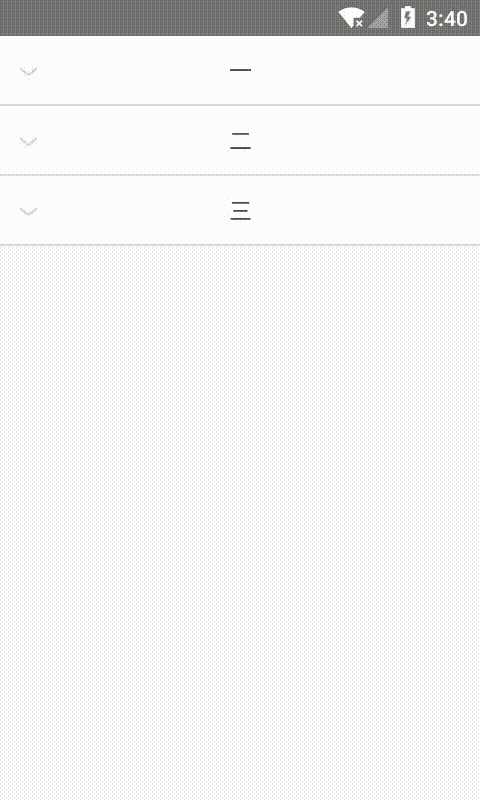Android开发 ExpandableListView 列表内容下拉View详解
Posted guanxinjing
tags:
篇首语:本文由小常识网(cha138.com)小编为大家整理,主要介绍了Android开发 ExpandableListView 列表内容下拉View详解相关的知识,希望对你有一定的参考价值。
前言
在需要实现一个List的item需要包含列表的时候,我们就可以选择ExpandableListView. 其实这个View的原始设计还是ListView的那套.就是增加2层的ListView而已.所以在写它的适配器与ListView的适配器挺相似的,所以会有一个通病就是没有Item的View的复用机制请一定要注意这点,在实现使用的时候需要写Item的View的复用,减少内存与增加性能.
一个简单的Demo
老规矩,先来一个最简单的demo来了解下最基本的使用方法.注意!这个demo是没有在Adapter写任何View复用机制的请不要用到实际项目中. demo只是帮助你快速认识了解ExpandableListView
效果图

Activity的Xml
<?xml version="1.0" encoding="utf-8"?> <LinearLayout xmlns:android="http://schemas.android.com/apk/res/android" xmlns:tools="http://schemas.android.com/tools" android:layout_width="match_parent" android:layout_height="match_parent" android:orientation="vertical" tools:context=".MainActivity"> <ExpandableListView android:id="@+id/expandablelistview" android:layout_width="match_parent" android:layout_height="match_parent"> </ExpandableListView> </LinearLayout>
一级Item和二级Item用的xml布局
偷懒,我让一级和二级都使用一个布局
<?xml version="1.0" encoding="utf-8"?> <TextView xmlns:android="http://schemas.android.com/apk/res/android" android:id="@+id/text1" android:layout_width="match_parent" android:layout_height="45dp" android:text="内容" android:textSize="15sp" android:textColor="@color/fontBlack3" android:gravity="center" android:background="@color/colorWhite"> </TextView>
编写适配器
import android.view.LayoutInflater; import android.view.View; import android.view.ViewGroup; import android.widget.BaseExpandableListAdapter; import android.widget.TextView; import java.util.List; public class DemoAdapter extends BaseExpandableListAdapter List<String> mGroupList;//一级List List<List<String>> mChildList;//二级List 注意!这里是List里面套了一个List<String>,实际项目你可以写一个pojo类来管理2层数据 public DemoAdapter(List<String> groupList, List<List<String>> childList) mGroupList = groupList; mChildList = childList; @Override public int getGroupCount() //返回第一级List长度 return mGroupList.size(); @Override public int getChildrenCount(int groupPosition) //返回指定groupPosition的第二级List长度 return mChildList.get(groupPosition).size(); @Override public Object getGroup(int groupPosition) //返回一级List里的内容 return mGroupList.get(groupPosition); @Override public Object getChild(int groupPosition, int childPosition) //返回二级List的内容 return mChildList.get(groupPosition).get(childPosition); @Override public long getGroupId(int groupPosition) //返回一级View的id 保证id唯一 return groupPosition; @Override public long getChildId(int groupPosition, int childPosition) //返回二级View的id 保证id唯一 return groupPosition + childPosition; /** * 指示在对基础数据进行更改时子ID和组ID是否稳定 * @return */ @Override public boolean hasStableIds() return true; /** * 返回一级父View */ @Override public View getGroupView(int groupPosition, boolean isExpanded, View convertView, ViewGroup parent) convertView = LayoutInflater.from(parent.getContext()).inflate(R.layout.text_item, parent,false); ((TextView)convertView).setText((String)getGroup(groupPosition)); return convertView; /** * 返回二级子View */ @Override public View getChildView(int groupPosition, int childPosition, boolean isLastChild, View convertView, ViewGroup parent) convertView = LayoutInflater.from(parent.getContext()).inflate(R.layout.text_item, parent,false); ((TextView)convertView).setText((String)getChild(groupPosition,childPosition)); return convertView; /** * 指定位置的子项是否可选 */ @Override public boolean isChildSelectable(int groupPosition, int childPosition) return true;
Activity里的代码
mExpandableListView = findViewById(R.id.expandablelistview); List<String> groupList = new ArrayList<>(); groupList.add("一"); groupList.add("二"); groupList.add("三"); List<List<String>> childList = new ArrayList<>(); List<String> childList1 = new ArrayList<>(); childList1.add("1"); childList1.add("1"); childList1.add("1"); List<String> childList2 = new ArrayList<>(); childList2.add("2"); childList2.add("2"); childList2.add("2"); List<String> childList3 = new ArrayList<>(); childList3.add("3"); childList3.add("3"); childList3.add("3"); childList.add(childList1); childList.add(childList2); childList.add(childList3); DemoAdapter demoAdapter = new DemoAdapter(groupList, childList); mExpandableListView.setAdapter(demoAdapter); mExpandableListView.setOnGroupClickListener(new ExpandableListView.OnGroupClickListener() //一级点击监听 @Override public boolean onGroupClick(ExpandableListView parent, View v, int groupPosition, long id) //如果你处理了并且消费了点击返回true,这是一个基本的防止onTouch事件向下或者向上传递的返回机制 return false; ); mExpandableListView.setOnChildClickListener(new ExpandableListView.OnChildClickListener() //二级点击监听 @Override public boolean onChildClick(ExpandableListView parent, View v, int groupPosition, int childPosition, long id) //如果你处理了并且消费了点击返回true return false; );
其他Xml属性
android:dividerHeight="20dp" 设置边距高度,注意设置这个边距包括了一级和二级
android:divider="@color/colorRed1" 设置一级边距的背景色
end
以上是关于Android开发 ExpandableListView 列表内容下拉View详解的主要内容,如果未能解决你的问题,请参考以下文章